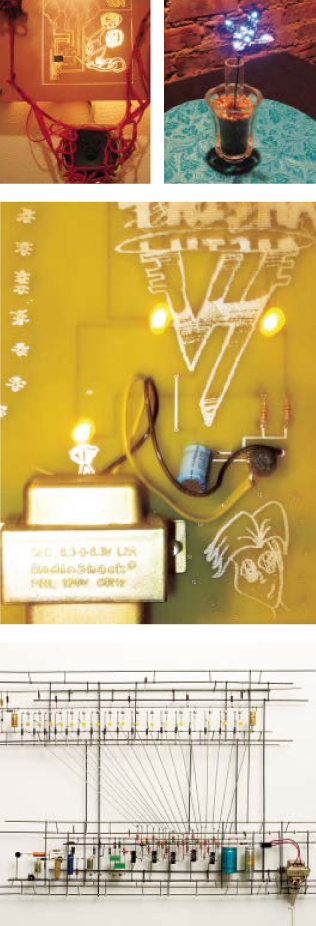ART WORK
Illuminated Circuits
AN ILLUMINATED MANUSCRIPT IS A TEXT with graphical embellishments: large, ornamented letters at the head of paragraphs; small paintings in the margins or interspersed within the text; borders dense with vines, patterns, and flowers. Sometimes the embellishments serve to clarify or enhance the meaning of the text; other times, the text seems merely an excuse for the intricate, exuberant illustrations. I’ve been thinking about illuminated manuscripts while looking at the work of a number of artists who are using circuit design as both a functional and an expressive medium. Let’s call these designs “illuminated circuits.”
The most straightforward way to illuminate a circuit is simply to embellish the functional electrical traces with additional not-so-functional designs. Paul Slocum’s AC 120V Weave and DC Power Supply are both electronically simple circuits made complex by the addition of extra traces in the form of school drawings and book-cover doodles from his youth. The circuits are simply “on” indicator lights, indicating the status of nothing in particular. One motivation for these pieces was Slocum’s involvement in the world of “circuit bending.” Many circuit benders not only modify the circuits of existing devices, but they also go on to decorate and enhance the original cases. Slocum wanted to focus solely on the idea of decorating machines, bypassing functionality altogether. These works are ornate circuits that do nothing but indicate their own presence.
LoVid (Tali Hinkis and Kyle Lapidus) takes a more involved approach in Hearing Red, a warm and buzzy ode to hearing loss. The circuit is a simple video generator that outputs an all-red image. Instead of running the video output into a monitor, it’s run through a small speaker so that you hear the static hum of the video sync signal. The rough, wiggly circuit traces were drawn based on the anatomy of the inner ear, focusing on areas that cause hearing impairment when damaged. Some of the traces are functional circuitry, while others are purely ornamental. Twisted and knotted red fabric, also inspired by aural anatomy, is woven through holes in the board. The circuit boards were milled out on a small CNC mill, removing some of the board substrate and allowing light to shine through the traces. To heighten the effect, lights are mounted behind the board, giving it a gentle glow and literally illuminating the circuit’s fanciful designs.
The circuits in Rob Seward’s Consciousness Field Resonator aren’t electronically embellished, but the PCBs they’re mounted on are hand-finished to give them a warm, aged look. CFR monitors the output statistics of random number generators,
The art and craft of circuit design is an open-ended endeavor, with enormous potential for both pragmatic invention and playful creativity.
lighting up when there’s a significant deviation from the expected values. Some experimenters, such as the Global Consciousness Project (see MAKE, Volume 09, page 62), claim that there’s a connection between highly emotional global events (like the death of a celebrity or a natural disaster) and the behavior of such sensitive electronic circuits. Seward isn’t trying to support or debunk that idea; rather, he wants to explore the human urge to make such connections even when they’re at odds with our rational thought processes. The mix of angular circuit traces, softly glowing LEDs, and burnished patina make CFR look like it’s out of the steampunk version of a Victorian natural history museum.
In addition to embellishing circuits, some artists ask questions about the basic physical form of the circuits themselves. Peter Blasser’s Rollz-5 drum machine schematics (available for free at ciat-lonbarde.net/rollz5) are meant to be printed and built on paper, with the component outlines printed on one side and lead connections on the other. You poke holes in the paper at the indicated spots, insert the components, and solder away! The transistor-based pulse generation circuits that provide the drum machine’s rhythms come in three, four, five, and six-node versions, and the number of nodes determines the visual shape of the circuit itself — three nodes make a triangle, four a square, and so on. The circuits and instruments Blasser designs are always functional, but their expressiveness comes as much from their playful visual appeal as from the sounds they make.
Peter Vogel’s interactive light and sound works and Michael Ang’s Blue Flower sculpture use electronic components as both circuit elements and physical structure. The etched-copper petals in Blue Flower function as power and ground rails, and the LEDs that run off those rails do double duty, both lighting the flower and holding the parts of the petals together. Ang’s elegant design is purposefully reminiscent of biological “design,” where each part of a flower serves a purpose. Vogel’s wiry constructions are much more industrial-looking; component leads are joined together to form columns, spirals, and physical supports for speakers, sensors, and LEDs. His light-sensitive piece Sounds is like an electronic Mondrian painting, colorful components arranged in interlocking geometric forms.

From top left: LoVid’s Hearing Red, Michael Ang’s Blue Flower, Paul Slocum’s DC Power Supply, Peter Vogel’s Moving Lights.
Photography by (from top left) LoVid, Michael Ang, Paul Slocum, Bitforms Gallery NYC
The art and craft of bookmaking have proceeded at a tremendous pace since the medieval heyday of illuminated manuscripts, as materials, techniques, and even motivations continually evolve. I imagine a similar trajectory for the art and craft of circuit design, an open-ended endeavor with enormous potential for both pragmatic invention and playful creativity.
Douglas Irving Repetto is an artist and teacher involved in a number of art/community groups including Dorkbot, ArtBots, Organizm, and Music-dsp.
